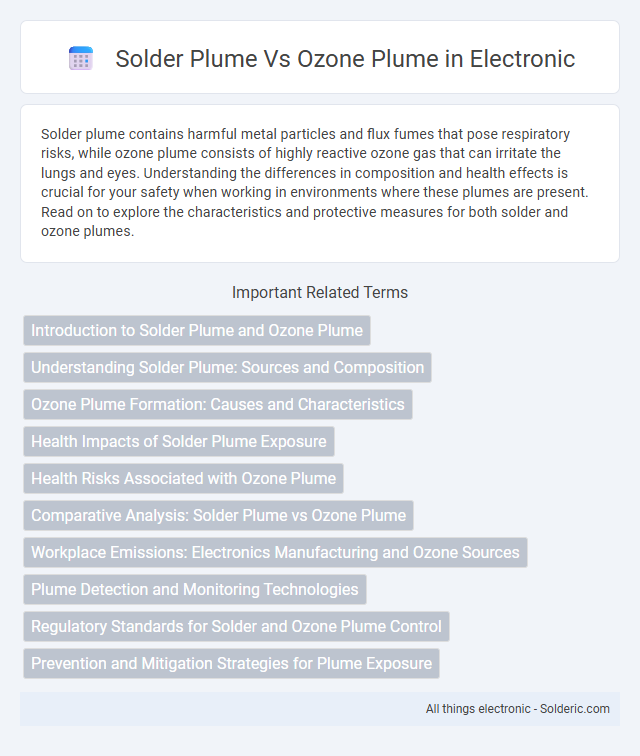Solder plume contains harmful metal particles and flux fumes that pose respiratory risks, while ozone plume consists of highly reactive ozone gas that can irritate the lungs and eyes. Understanding the differences in composition and health effects is crucial for your safety when working in environments where these plumes are present. Read on to explore the characteristics and protective measures for both solder and ozone plumes.
Comparison Table
| Aspect | Solder Plume | Ozone Plume |
|---|---|---|
| Source | Fumes generated during soldering processes | Ozone gas generated from electrical discharges or UV lamps |
| Composition | Metal oxides, flux vapors, particulate matter | Triatomic oxygen (O3) molecules |
| Health Impact | Irritates eyes, respiratory tract; potential toxic exposure | Respiratory irritant; high levels cause lung damage |
| Detection | Air quality sensors, particulate monitors | Ozone analyzers, UV photometric sensors |
| Control Methods | Local exhaust ventilation, fume extraction systems | Ozone destruct units, controlled ventilation |
| Environmental Effect | Indoor air contamination; minimal outdoor impact | Contributes to smog formation and oxidative damage outdoors |
Introduction to Solder Plume and Ozone Plume
Solder plume consists of particulate matter and fumes generated during the soldering process, containing metals and flux residues that can affect air quality and health. Ozone plume refers to the release of ozone gas, often produced during processes involving UV light or electrical discharges, which can cause respiratory irritation and environmental concerns. Understanding the differences between solder plume and ozone plume is essential for implementing effective ventilation and safety measures to protect your workspace.
Understanding Solder Plume: Sources and Composition
Solder plume primarily originates from the vaporization of flux components and heated solder materials during the soldering process, releasing particles containing rosin, metal oxides, and organic compounds. This complex mixture poses respiratory risks and requires effective ventilation and filtration systems to protect workplace air quality. Understanding these sources helps you implement targeted controls to minimize exposure and ensure safe soldering environments.
Ozone Plume Formation: Causes and Characteristics
Ozone plume formation primarily results from the reaction between nitrogen oxides (NOx) and volatile organic compounds (VOCs) under sunlight, generating high concentrations of ozone in localized areas. Unlike the dense particulate matter found in solder plumes, ozone plumes consist mainly of gaseous pollutants that can disperse over larger distances, posing respiratory risks and environmental impacts. Understanding your exposure to ozone plumes requires monitoring air quality and controlling emissions of precursor chemicals to mitigate health hazards associated with ozone pollution.
Health Impacts of Solder Plume Exposure
Solder plume exposure contains hazardous metal fumes and flux vapors that can cause respiratory irritation, asthma, and long-term lung damage. Ozone plumes generated during certain soldering processes contribute to oxidative stress and airway inflammation, intensifying respiratory health risks. Managing your exposure to both solder and ozone plumes is essential to protect lung function and overall respiratory health in soldering environments.
Health Risks Associated with Ozone Plume
Ozone plumes generated during soldering processes contain high levels of oxidative agents that can irritate the respiratory system, leading to symptoms such as coughing, throat irritation, and shortness of breath. Exposure to ozone plumes may exacerbate asthma, reduce lung function, and increase the risk of chronic respiratory diseases by damaging airway tissues over time. Protecting your workplace with proper ventilation and ozone filtration is essential to minimize health risks associated with prolonged inhalation of ozone plumes.
Comparative Analysis: Solder Plume vs Ozone Plume
Solder plume consists of metal oxides and flux vapors released during soldering, presenting health risks from inhaling particulate matter and chemicals, while ozone plume results from high-voltage electrical discharges generating reactive oxygen species that can irritate respiratory tissues. Exposure to solder plume primarily causes respiratory and skin irritation due to metal particles, whereas ozone plume exposure leads to oxidative stress and inflammation in lung tissue. Understanding your workplace environment's plume type guides appropriate ventilation and protective equipment choices to minimize health hazards.
Workplace Emissions: Electronics Manufacturing and Ozone Sources
Solder plume emissions in electronics manufacturing primarily consist of particulate matter and volatile organic compounds (VOCs) released during soldering processes, posing respiratory hazards to workers. In contrast, ozone plumes mainly originate from photochemical reactions involving nitrogen oxides (NOx) and VOCs, often exacerbated by industrial emissions and equipment used in manufacturing environments. Effective ventilation and air filtration systems are critical to mitigating the health risks associated with both solder and ozone plumes in workplace settings.
Plume Detection and Monitoring Technologies
Advanced plume detection and monitoring technologies for solder and ozone plumes utilize infrared spectroscopy and electrochemical sensors to identify specific molecular signatures. Real-time air quality monitoring systems integrate laser-based photoacoustic detection and metal-oxide semiconductor sensors to accurately quantify plume concentration and dispersion. Data analytics platforms enhance plume source identification and predictive modeling, improving workplace safety and environmental compliance.
Regulatory Standards for Solder and Ozone Plume Control
Regulatory standards for solder plume control emphasize limits on particulate matter and volatile organic compounds (VOCs) to reduce respiratory hazards and workplace exposure, often governed by OSHA and EPA guidelines. Ozone plume control is regulated by setting maximum allowable concentrations due to ozone's strong oxidizing properties and potential environmental impact, with standards established by organizations like the Occupational Safety and Health Administration (OSHA) and the National Institute for Occupational Safety and Health (NIOSH). You must ensure compliance with these regulations by implementing adequate ventilation, filtration, and monitoring systems tailored to the specific plume type in your facility.
Prevention and Mitigation Strategies for Plume Exposure
Effective prevention and mitigation strategies for solder plume and ozone plume exposure include enhancing ventilation systems to capture and remove harmful particulates and gases at their source. Utilizing high-efficiency particulate air (HEPA) filters and activated carbon filters can significantly reduce airborne contaminants, protecting Your respiratory health. Personal protective equipment (PPE) such as respirators and regular monitoring of air quality are essential to minimize exposure risks in environments prone to plume generation.
Solder plume vs ozone plume Infographic

 solderic.com
solderic.com